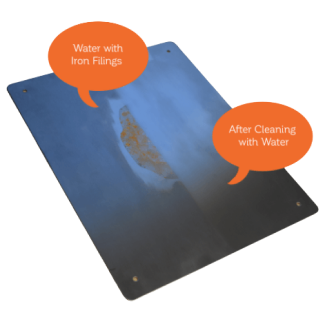How to clean rust off stainless steel
304 stainless steel is a tough, long lasting, durable metal. However under certain conditions, it can appear to rust. This is natural reaction, usually between the surface of the steel and its surroundings, and the good news is there are many things you can do to prevent this reaction or clean the rust off the steel using the correct cleaning procedure.
What causes stainless steel to rust and how to prevent it
Stainless reacts with certain elements in the air and water, and this is what causes rust patches. The tables below show how much concentrate of each of the following corrosives that 304 and 316 stainless steel can handle:
304 GRADE
| Corrosive | Strength | Temp |
|---|---|---|
| Chloride Ions | Up to 200ppm (mg/litre) | - |
| Acetic Acid | 20% | 80°C |
| Formic Acid | 90% | 20°C |
| Phospohoric Acid | 20% | 60°C |
| Nitric Acid | 20% | 50°C |
| Sulphuric Acid | 90% | 20°C |
| Beer | 100% | - |
| Milk | 100% | - |
| Wine/Juice | 100% | - |
| Bleach (neat) | None | - |
| Salt water & air | Dependant on finish* | - |
316 GRADE
| Corrosive | Strength | Temp |
|---|---|---|
| Chloride Ions | Up to 1000ppm (mg/litre) | - |
| Acetic acid | 50% | Boiling Temp |
| Formic acid | 100% | 60°C |
| Phosphoric Acid | 20% | Boiling Temp |
| Tartaric acid | 60% | 80°C |
| Sulphuric Acid | 20% | 20°C |
| Beer | 100% | - |
| Milk | 100% | - |
| Petrol | 100% | - |
| Bleach (neat) | Heavily diluted (1/10 water) | - |
| Salt water & air | Dependant on finish* | - |
*With salt water and air, it is proven that 316 lasts must longer in seaside environments. However the finish on the steel is important, as the rougher the steel, the easier it is for salt to get into the steel top layer and begin corrosion.
Insufficient cleaning and the atmosphere in which the steel sits add to these elements, making rust appear. By keeping to a regular cleaning routine, you can help to prevent this from happening.

How To Remove The Rust?
Rust marks or staining on stainless steel is highly unlikely to be the result of corrosion to the stainless steel itself (similar marks may also be found on porcelain and plastic sinks). These marks are likely to result from small particles of carbon steel from wire wool or scouring pads become attached or embedded in the surface. In the damp environment of a sink, these iron particles rust and cause staining.
If the rust has occurred there are certain ways you can remove it.
- Water
A clean cloth and warm water should remove light rust.
- Stainless steel cleaner
You can buy cleaners specifically designed for removing and preventing rust.
- Nylon abrasive pad (Carbon steel wool should NOT be used as this will react)
This can be used for tougher rust in the direction of the grain.
- Rubbing block
comprising fine abrasive in a hard rubber or plastic filler - Always go with the grain using abrasives.
- 10% phosphoric acid solution –
For stubborn rust, this must be followed by ammonia and water rinses to prevent damage.
- Oxalic acid solution
For stubborn rust where particles have been embedded in the surface. This must be followed by water rinses to prevent damage. Special precautions are necessary with oxalic acid, as, although it may not 'burn' unprotected skin, it is poisonous, if ingested. The cleaning solution should be applied with a swab and allowed to stand for 15-20 minutes before being washed away with water.
Always rinse well with clean water after using any acids on stainless steel, and take all health and safety precautions necessary when using strong acids.
Looking for general care and maintenance? View our guide here
Need advice about stainless steel?
If you would like advice on the best grade of stainless steel for your product please call +44(0)1603 788 833 to speak to one of our Teknomexperts.
Contact us today

